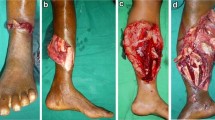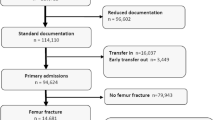Abstract
Background
Various open injury scores have been devised to aid the difficult decision of salvage or amputation following open fractures of the lower limb. Our aim of the study was to compare the performance of mangled extremity severity score (MESS), limb salvage index (LSI), orthopaedic trauma association-open fracture classification (OTA-OFC) and Ganga hospital score (GHS) in our population of type IIIB injuries.
Materials and methods
A total of 219 patients with 225 type IIIB open fractures of the tibia were studied prospectively between July 2016 and June 2017. The decision of salvage or amputation was taken by a combined consensus of senior orthopaedic and plastic surgeons, blinded to the scores. All four open injury scores were calculated by an independent reviewer following initial debridement. The follow-up period was one to two years.
Results
After final follow-up, there were 193 (85.7%) successfully salvaged limbs, 19 primary amputations without attempt of debridement (8.4%), three primary delayed amputations within 72 hours (1.3%) and six secondary amputations after 72 hours from initial debridement (2.7%). Of these, four patients died within one year and were excluded. All four scores performed well for salvage, while GHS was superior when considering amputation. MESS, LSI and OTA-OFC underscored amputations, since these scoring systems award more points for vascular injuries. There were both salvaged and amputated patients around the threshold value of amputation for all scores, which was only acknowledged by GHS in its unique ‘grey zone’. It includes patients who are neither easily salvageable nor definitely requiring amputation.
Conclusion
The performance of the GHS was superior to MESS, LSI and OTA-OFC in our study, since it was developed for type IIIB injuries and includes the ‘grey zone’, where decisions need to be undertaken on a case to case basis.
Clinical relevance
GHS has an improved ability to determine amputation in IIIB open tibia fractures.


Similar content being viewed by others
References
Ebskov LB (1994) Salvage of extremities or amputation in severe traumas. Ugeskr Laeger 156(24):3625–3631
Court-Brown CM, Rimmer S, Prakash U, McQueen MM (1998) The epidemiology of open long bone fractures. Injury 29(7):529–534
Nanchahal J, Nayagam S, Khan U, Moran C, Barrett S, Sanderson F, Pallister I (2009) Standards for the management of open fractures of the lower limb. British Association of Plastic Reconstructive and Aesthetic Surgeons and British Orthopaedic Association ISBN: 978-1-85315-911-4
Rajasekaran S, Sabapathy SR, Dheenadhayalan J, Sundararajan SR, Venkatramani H, Devendra A, Ramesh P, Srikanth KP (2015) Ganga hospital open injury score in management of open injuries. Eur J Trauma Emerg Surg 41:3–15. https://doi.org/10.1007/s00068-014-0465-9
Busse JW, Jacobs CL, Swiontkowski MF, Bosse MJ, Bhandari M (2007) Complex limb salvage or early amputation for severe lower-limb injury: a meta-analysis of observational studies. J Orthop Trauma 21(1):70–76. https://doi.org/10.1097/bot.0b013e31802cbc43
Shanmuganathan R (2008) The utility of scores in the decision to salvage or amputation in severely injured limbs. Indian J Orthop 42(4):368–376
Durham RM, Mistry BM, Mazuski JE, Shapiro M, Jacobs D (1996) Outcome and utility of scoring systems in the management of the mangled extremity. Am J Surg 172(5):569–573 573-574
Caudle RJ, Stern PJ (1987) Severe open fractures of the tibia. JBJS 69(6):801–807 PMID: 3597491
Rajasekaran S, Naresh Babu J, Dheenadhayalan J, Shetty AP, Sundararajan SR, Kumar M, Rajasabapathy S (2006) A score for predicting salvage and outcome in Gustilo type-IIIA and type-IIIB open tibial fractures. J Bone Joint Surg (Br) 88(10):1351–1360
Sharma S, Devgan A, Marya KM, Rathee N (2003) Critical evaluation of mangled extremity severity scoring system in Indian patients. Injury 34(7):493–496
Kumar MK, Badole C, Patond K (2007) Salvage versus amputation: utility of mangled extremity severity score in severely injured lower limbs. Indian J Orthop 41(3):183–187
Gregory RT, Gould RJ, Peclet M, Wagner JS, Gilbert DA, Wheeler JR, Snyder SO, Gayle RG, Schwab CW (1985) The mangled extremity syndrome (M.E.S.): a severity grading system for multisystem injury of the extremity. J Trauma 25(12):1147–1150 PMID: 3934398
Brown KV, Ramasamy A, McLeod J, Stapley S, Clasper JC (2009) Predicting the need for early amputation in ballistic mangled extremity injuries. J Trauma 66:93–97
Ege T, Unlu A, Tas H, Bek D, Turkan S, Cetinkaya A (2015) Reliability of the mangled extremity severity score in combat-related upper and lower extremity injuries. Indian J Orthop 49(6):656–660
Sheean AJ, Krueger CA, Napierala MA, Stinner DJ, Hsu JR (2014) Skeletal Trauma and Research Consortium (STReC). Evaluation of the mangled extremity severity score in combat-related type III open tibia fracture. J Orthop Trauma 28(9):523–526
Doucet JJ, Galarneau MR, Potenza BM, Bansal V, Lee JG, Schwartz AK (2011) Combat versus civilian open tibia fractures: the effect of blast mechanism on limb salvage. J Trauma 70(5):1241–1247
Johannsen K, Hansen ST (2015) MESS (mangled extremity severity score) 25 years on: time for a reboot? J Acute Trauma Care Surg 79(3):495–496
Rush RM Jr, Kjorstad R, Starnes BW, Arrington E, Devine JD, Andersen CA (2007) Application of the mangled extremity severity score in a combat setting. Mil Med 172:777–781
Higgins TF, Klatt JB, Beals TC (2010) Lower Extremity Assessment Project (LEAP) - the best available evidence on limb-threatening lower extremity trauma. Orthop Clin North Am 41(2):233–239
Johansen K, Daines M, Howey T, Helfet D, Hansen ST (1990) Objective criteria accurately predict amputation following lower extremity trauma. J Trauma 30(5):568–572 572-573
Russell WL, Sailors DM, Whittle TB, Fisher DF, Burns RP (1991) Limb salvage versus traumatic amputation. A decision based on a seven-part predictive index. Ann Surg 213(5):473–480 480-481
Orthopaedic Trauma Association: Open Fracture Study Group (2010) A new classification scheme for open fractures. J Orthop Trauma 24(8):457–464
Schenker ML, Yannascoli S, Baldwin K, Jaimo AJ, Mehta S (2012) Does Timing to Operative Debridement Affect Infectious Complications in Open Long-Bone Fractures? A Systematic Review. J Bone Joint Surg Am 94(12):1057–1064. https://doi.org/10.2106/JBJS.K.00582
Hao J, Cuellar DO, Herbert B, Kim JW, Chadayammuri V, Casemyr N, Hammerberg ME, Stahel PF, Hak DJ, Mauffrey C (2016) Does the OTA open fracture classification predict the need for limb amputation? A retrospective observational cohort study on 512 patients. J Orthop Trauma 30(4):194–198. https://doi.org/10.1097/BOT.0000000000000479
Rajasekaran S, RajaSabapathy S (2007) A philosophy of care of open injuries based on the Ganga hospital score. Injury 38(2):137–146
Venkatadass K, Grandhi TSP, Rajasekaran S (2017) Use of Ganga Hospital Open Injury Severity Scoring for determination of salvage versus amputation in open type IIIB injuries of lower limbs in children—an analysis of 52 type IIIB open fractures. Injury 48(11):2509–2514
Madhuchandra P, Rafi M, Devadoss S, Devadoss A (2015) Predictability of salvage and outcome of Gustilo and Anderson type-IIIA and type-IIIB open tibial fractures using Ganga Hospital Scoring system. Injury 46(2):282–287
Funding
This study was funded by the Ganga Orthopaedic Research Education Foundation (GOREF), Coimbatore, India.
Author information
Authors and Affiliations
Corresponding author
Ethics declarations
Conflict of interest
The authors declare that they have no conflict of interest.
Ethical approval
Approval was gained from the Ganga Hospital IRB.
Additional information
Publisher’s note
Springer Nature remains neutral with regard to jurisdictional claims in published maps and institutional affiliations.
Level of Evidence: III
Rights and permissions
About this article
Cite this article
Gupta, A., Parikh, S., Rajasekaran, R.B. et al. Comparing the performance of different open injury scores in predicting salvage and amputation in type IIIB open tibia fractures. International Orthopaedics (SICOT) 44, 1797–1804 (2020). https://doi.org/10.1007/s00264-020-04538-5
Received:
Accepted:
Published:
Issue Date:
DOI: https://doi.org/10.1007/s00264-020-04538-5




